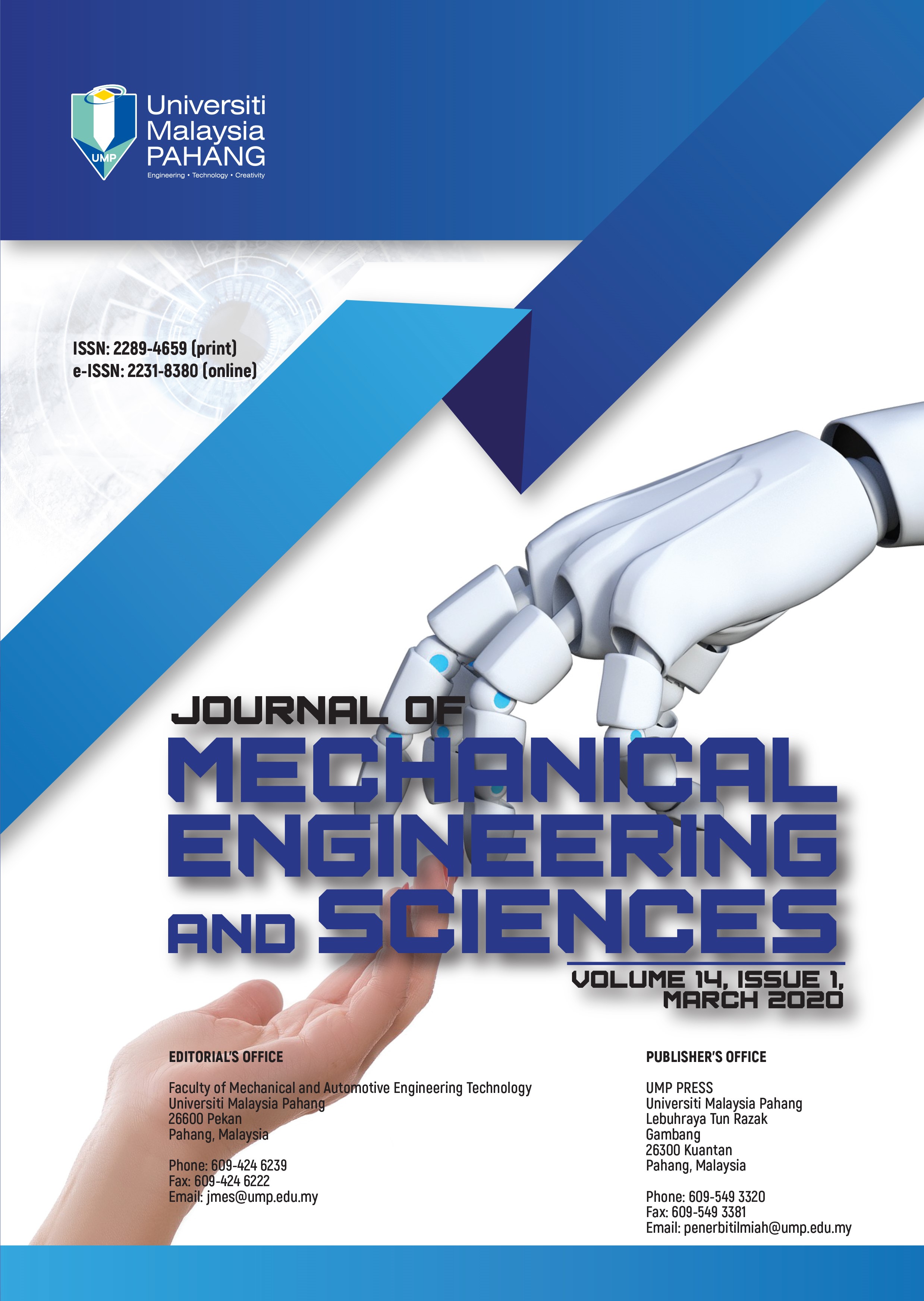Performance and exhaust gases of a diesel engine using different magnetic treatments of the fuel
DOI:
https://doi.org/10.15282/jmes.14.1.2020.07.0492Keywords:
internal combustion engines, magnetic treatment of fuel, magnetic conditioners, magnets, gases emissionsAbstract
In this research, different magnetic treatments were applied to diesel fuel using static magnetic fields of 0.36T of magnetic induction. The magnetic conditioners (MCs) were installed in different positions of the fuel lines in the engine and the magnetic treatment of the diesel was also carried out before introducing it into the engine tanks. The study was conducted using a four-stroke, two-cylinder, Lister Petter (LPWS2) engine with a compression ratio of 23.5:1 and a constant engine speed of 1500 rpm. The emissions of carbon monoxide (CO), carbon dioxide (CO2), oxygen (O2), nitrogen oxides and the temperature of the exhaust gases and the mass consumption of fuel were measured. The highest levels of reduction were achieved with the magnetic treatments that locate the MC directly in the engine's pipes. As the number of MC in the engine pipes increases, the emissions of polluting gases decrease. With the treatment that locates one MC in front of each injector, two MC at the entrance of the filter and two MC in the return of fuel were able to increase the O2 emissions by 6.9% and decrease the CO emissions in about 21.3% in the last load of the generator set. With this treatment a decrease in fuel consumption of 4.89% to 80% of engine load was obtained.
References
Nufus TH, Setiawan RPA, Hermawan W, Tambunan AH. Characterization of biodiesel fuel and its blend after electromagnetic exposure. Cogent Engineering. 2017; 4(1):1-12.
Gaurav N, Sivasankari S, Kiran G, Ninawe A, Selvin J. Utilization of bioresources for sustainable biofuels: A Review. Renewable and Sustainable Energy Reviews. 2017; 73: 205-214.
Arvindnarayan S, Prabhu KKS, Shobana S, Dharmaraja J, Pasupathy A. Algal biomass energy carriers as fuels: An alternative green source. Journal of the Energy Institute. 2017; 90(2):300-315.
Johnson KG, Mollenhauer K, Tschöke H. Handbook of diesel engines. New York: Springer Science & Business Media; 2010.
Boubel RW, Vallero D, Fox DL, Turner B, Stern AC. Fundamentals of air pollution. Third Edition. San Diego: Elsevier; 2013.
Abdul WHA, Al-Kayiem HH, A. Aziz AR, Nasif MS. Survey of invest fuel magnetization in developing internal combustion engine characteristics. Renewable and Sustainable Energy Reviews. 2017; 79: 1392–1399.
Chen C-Y, Lee W-J, Mwangi JK, Wang L-C, Lu J-H. Impact of Magnetic Tube on Pollutant Emissions from the Diesel Engine. Aerosol and Air Quality Research. 2017; 17(4):1097-1104.
Zannis TC, Hountalas DT, Papagiannakis RG. Experimental study of diesel fuel effects on direct injection (DI) diesel engine performance and pollutant emissions. Energy & fuels. 2007; 21(5):2642-2654.
Pérez SA, Montero A, Gisela, Ayala BR, Coronado OMA, Campbell RHE, García GC. Simulación en Aspen de la combustión de mezclas diesel-biodiesel. Ingeniería, investigación y tecnología. 2015; 16(1):83-92.
Saladini F, Patrizi N, Pulselli FM, Marchettini N, Bastianoni S. Guidelines for emergy evaluation of first, second and third generation biofuels. Renewable and Sustainable Energy Reviews. 2016; 66: 221-227.
Karavalakis G, Durbin TD, Shrivastava M, Zheng Z, Villela M, Jung H. Impacts of ethanol fuel level on emissions of regulated and unregulated pollutants from a fleet of gasoline light-duty vehicles. Fuel 2012; 93: 549-558.
Melo EEA, Sánchez BY, Ferrer FN, Ferrer FN. Evaluación de un motor de encendido por chispa trabajando con mezclas etanol-gasolina. Ingeniería Energética. 2012; 33(2):94-102.
Solmaz H. Combustion, performance and emission characteristics of fusel oil in a spark ignition engine. Fuel Processing Technology. 2015; 133: 20-28.
Melo EA, Piloto RR, Sierens R, Verhelst S. Emulsification of waste cooking oils and fatty acid distillates as diesel engine fuels: An attractive alternative. International Journal of Sustainable Energy Planning and Management. 2016; 9: 3-16.
Piloto RR, Sánchez BY, Melo EEA, Verhelst S. Assessment of diesel engine performance when fueled with biodiesel from algae and microalgae: An overview. Renewable and Sustainable Energy Reviews. 2017; 69: 833-842.
Devarajan Y, Munuswamy DB, Mahalingam AP. Performance, combustion and emission analysis on the effect of ferrofluid on neat biodiesel. Process Safety and Environmental Protection. 2017; 111: 283-291.
Karthik N, Xavier XG, Rajasekar R, Bairavan PG, Dhanseelan S. Experimental Investigation of Performance and emission characteristics of Various Nano Particles with Bio-Diesel blend on Di Diesel Engine. In: IOP Conference Series: Materials Science and Engineering. 012014, 2017.
Govindasamy P, Dhandapani S. Effects of EGR & Magnetic Fuel Treatment System on Engine Emission Characteristics in A Bio Fuel Engine. In: Proceedings of the International Conference on Mechanical Engineering. Bangladesh; 26-28, 2009.
Fedorchak V, Fedorchak T. Analysis and classification of physical and chemical methods of fuel activation. Ovidius University Annals of Chemistry. 2015; 26(2):67-73.
Tao R, Huang K, Tang H, Bell D. Electrorheology improves engine efficiency. In: Journal of Physics: Conference Series. 12-30, 2009.
Du E, Tang H, Huang K, Tao R. Reducing the viscosity of diesel fuel with electrorheological effect. Journal of Intelligent Material Systems and Structures. 2011; 22(15):1713-1716.
Chavan MS, Jhavar MP. Effect of Application of Magnetic Field on Emission of Petrol Engine. Imperial Journal of Interdisciplinary Research. 2016; 2(10):2121-2128.
Petkar NN, Khamkar PK. Performance and emission analysis of magnetic fuel energizer for motorcycles. Int. J. Adv. Res. ScI. Eng. Technol. 2016; 5:300-306.
Nilesh WT, Tushar AK, Patil VH. A review on effect of magnetic field to improve fuel consumption in S.I. Engine. In: National Conference on Current Trends in Engineering, Science, Technology and Management (NACCTESTM-2017). Jalgaon-India; 2017:345-349.
Raut MS, Uparwat SS, Nagarale C. Experimental Inspection by using the Effect of Magnetic Field on the Performance of Diesel Engine. International Research Journal of Engineering and Technology (IRJET). 2017; 4(3):2191-2194.
Hasegawa M, Mukohara S, Tachiban Y. Influence of magnetic field on kinematic viscosity of fuel oil. In: 8th Int Symp on Alcohol Fuels. 1988.
Faris AS, Al-Naseri SK, Jamal N, Isse R, Abed M, Fouad Z, Kazim A, Reheem N, Chaloob A, Mohammad H. Effects of Magnetic Field on Fuel Consumption and Exhaust Emissions in Two-Stroke Engine. Energy Procedia. 2012; 18: 327-338.
Aktar AR, Tipole P, Bhojwani V, Deshmukh S. Effect of magnetic field strength on hydrocarbon fuel viscosity and engine performance. IJMCA 2013; 1(7):094-098.
Calabrò E, Magazù S. FTIR Spectroscopy analysis of molecular vibrations in gasoline fuel under 200 mT static magnetic field highlighted structural changes of hydrocarbons chains. Petroleum Science and Technology. 2015; 33(19):1676-1684.
Al Ali Y, Hrairi M, Al Kattan I. Potential for improving vehicle fuel efficiency and reducing the environmental pollution via fuel ionization. International Journal of Environmental Science and Technology. 2012; 9(3):495-502.
Arias GR, Berenguer UM, Vázquez NJA, Silveira FY, Alfaro RCE. Reducción de las emisiones gaseosas de un grupo electrógeno con tratamiento magnético al combustible Cuba: Medio Ambiente y Desarrollo. 2016; 30:1-7.
Tipole P, Karthikeyan A, Bhojwani V, Deshmukh S, Babar H, Tipole B. Reduction in the exhaust emissions of four-stroke multi-cylinder SI Engine on application of multiple pairs of magnets. International Journal of Ambient Energy. 2017; 29(8):1-7.
Al-Khaledy AAJ. High performance and low pollutant emissions from a treated diesel fuel using a magnetic field. Al-Qudsiya Journal for Engineering Sciences. 2008; 1(2):211-224.
Patel PM, Rathod GP, Patel TM. Effect of magnetic field on performance and emission of single cylinder four stroke diesel engine. IOSRJEN 2014; 4(5):28-34.
Arias GR, Berenguer UM, Vázquez NJA, Silveira FY, Alfaro RCE. Disminución de las emisiones de monóxido de carbono con el tratamiento magnético del combustible Centro Azúcar. 2018; 45(1):21-31.
Govindasamy P, Dhandapani S. Experimental investigation of cyclic variation of combustion parameters in catalytically activated and magnetically energized two-stroke SI engine. Journal of Energy & Environment. 2007; 6: 45-59.
El Fatih F, Saber G. Effect of fuel magnetism on engine performance and emissions. Australian Journal of Basic and Applied Sciences. 2010; 4(2):6354-6358.
Cogollos JB, Vega JRF, Medina AS, Morales GBC. Influencia del tratamiento magnético en los parámetros de salida del motor D-65. Centro Azúcar. 2000; 27(1): 19-25.
Keating EL. Applied combustion. Second Edition New York: CRC press Taylor & Francis Group; 2007.
Arias GR, Silveira FY, Campos SM, Falcón HJ. Efecto de un campo magnético estático en la tensión superficial del diésel y su atomización Revista Iberoamericana de Ingeniería Mecánica. 2018; 22(1):9-21.
Bhaskar K, Sendilvelan S. Experimental studies on the performance and emission characteristics of a compression ignition engine fuelled with jatropha oil methyl ester. Journal of Mechanical Engineering and Sciences. 2018; 12(1): 3431-3450.
Yusop A, Mamat R, Mat Yasin M, Ali OM. Effects of particulate matter emissions of diesel engine using diesel–methanol blends. Journal of Mechanical Engineering and Sciences. 2014; 6:959-967.
Bhaskar K, Sendilvelan S, Muthu V, Aravindraj S. Performance and emission characteristics of compression ignition engine using methyl ester blends of jatropha and fish oil. Journal of Mechanical Engineering and Sciences. 2016; 10(2):1994-2007.
Loskutov YV, Yudina N. Rheological behavior of oils in a magnetic field. Journal of Engineering Physics and Thermophysics. 2006; 79(1):105-113.
Arias GR, Falcón HJ, Campos SM, Silveira FY, López GÓ. Efecto del tratamiento magnético en el comportamiento reológico del diésel. Revista Tecnología Química. 2018; 38(2):412-427.
Campos SM, Moro MA, Silveira FY. Comportamiento reológico de emulsiones de agua en petróleo (w/o) tratadas magnéticamente. Tecnología Química. 2018; 38(1):58-70.
Downloads
Published
Issue
Section
License
Copyright (c) 2020 The Author(s)

This work is licensed under a Creative Commons Attribution-NonCommercial 4.0 International License.






